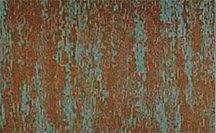The Board affirmed a Section 2(a) refusal of the mark COPPER-TEN, finding it to be deceptive for “prepainted coated sheet steel, namely, coated sheet steel painted to simulate naturally weathered copper.” Applicant argued that the mark accurately describes the visual appearance of the goods, and therefore that consumers would not be deceived, particularly in light of applicant’s family of marks: GALV-TEN, COR-TEN AZP, and DUAL-TEN for other steel products. In re United States Steel Corporation, Serial No. 86174180 (April 8, 2016) [not precedential].

A mark is deceptive under Section 2(a) if (1) it misdescribes the goods, (2) prospective purchasers would believe the misdescription, and (3) the misdescription is likely to affect the purchasing decision of a significant portion of relevant consumers. Moreover, a mark is deceptive even if only a portion of the mark is deceptive.
Applicant maintained that purchasers would not understand the term COPPER to indicate that the material contains copper. The Board, however, swiftly rejected the “family of marks” argument, failing to see how this supposed family would “transform an unregistrable mark into a source indicator.” In any case, there was no proof that applicant used its marks in such a way as to create a family of marks. [Even if a family of marks existed, what if tomorrow applicant abandoned the other marks in the family? – ed.].
Applicant also pointed to its advertising, which explained the nature of the goods. The Board noted, however, that the mark must stand on its own. [As with the family argument, applicant could change its advertising tomorrow – ed.].
The Board concluded that the first prong of the Section 2(a) deceptiveness test was satisfied.
Because copper is a common feature or ingredient of building materials, consumers are likely to mistakenly believe that the involved goods are made of copper. And so the second prong was satisfied. Applicant’s assertion that the customers for the goods are sophisticated was unpersuasive. The identification of goods encompassea materials that may be purchased by do-it-yourself consumers and handymen at a building supply store like Home Depot of Lowe’s. And there was no direct evidence to support the claim that consumers are not likely to be deceived.
Finally, genuine copper is commonly used and highly desirable for building materials. Thus the misdescription of the mark would be a material factor in the consumer’s purchasing decision.
And so the Board affirmed the refusal.

